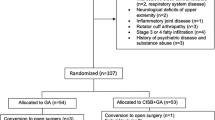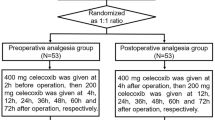Abstract
Purpose
This prospective study was undertaken to compare the effectiveness and safety of a multimodal pain control protocol with those of intravenous patient-controlled analgesia in rotator cuff repair.
Methods
Seventy patients scheduled for rotator cuff repair were randomized to either a multimodal pain control group (group 1, 40 patients) or an intravenous patient-controlled analgesia group (group 2, 30 patients). We compared these two groups with respect to level of pain before surgery to the fifth postoperative day, duration of postoperative rehabilitation, consumption of additional analgesics, and adverse effects.
Results
Mean visual analogue scale scores immediately after surgery (day 0) and on postoperative days 1–5 were 6.9, 5.5, 4.3, 3.3, 3.0, and 2.6 in group 1 and 7.8, 5.9, 4.4, 4.7, 4.3, and 3.7 in group 2. Pain relief was significantly better in group 1 on days 0, 3, 4, and 5 (P = 0.026, 0.006, 0.010, and 0.009, respectively). Furthermore, functional recovery occurred earlier in group 1. No significant differences were observed between the two groups with respect to nausea, vomiting, urinary retention, and headache (n.s.), but group 1 was found to be significantly less likely to experience dizziness or urticaria (P = 0.007, 0.017, respectively). One other significant difference was observed: 1 patient (2.5%) in group 1 and 6 patients (20%) in group 2 discontinued regimen because of medication-related adverse effects (P = 0.016).
Conclusion
The multimodal pain control protocol was found to offer more effective postoperative pain control with fewer adverse effects than intravenous patient-controlled analgesia. However, achieving adequate pain control within the first 48 h of surgery remains challenging, and thus, the developments of more effective and safer multimodal pain control protocols are required.

Similar content being viewed by others
References
Albert TJ, Cohn JC, Rothman JS, Springstead J, Rothman RH, Booth RE Jr (2001) Patient-controlled analgesia in a postoperative total joint arthroplasty population. J Arthroplasty 6:23–28
Bishop JY, Sprague M, Gelber J, Krol M, Rosenblatt MA, Gladstone J, Flatow EL (2005) Interscalene regional anesthesia for shoulder surgery. J Bone Joint Surg Am 87:974–979
Boss AP, Maurer T, Seiler S, Aeschbach A, Hintermann B, Strebel S (2004) Continuous subacromial bupivacaine infusion for postoperative analgesia after open acromioplasty and rotator cuff repair: preliminary results. J Shoulder Elbow Surg 13:630–634
Burns JW, Hodsman NB, McLintock TT, Gillies GW, Kenny GN, McArdle CS (1989) The influence of patient characteristics on the requirements for postoperative analgesia: a reassessment using patient-controlled anesthesia. Anaesthesia 44:2–6
Capdevila X, Barthelet Y, Biboulet P, Ryckwaert Y, Rubenovitch J, d’Athis F (1999) Effects of perioperative analgesic technique on the surgical outcome and duration of rehabilitation after major knee surgery. Anesthesiology 91:8–15
Cho NS, Ha JH, Rhee YG (2007) Patient-controlled analgesia after arthroscopic rotator cuff repair: subacromial catheter versus intravenous injection. Am J Sports Med 35:75–79
Cohen DB, Kawamura S, Ehteshami JR, Rodeo SA (2006) Indomethacin and celecoxib impair rotator cuff tendon-to-bone healing. Am J Sports Med 34:362–369
Dorr LD, Raya J, Long WT, Boutary M, Sirianni LE (2008) Multimodal analgesia without parenteral narcotics for total knee arthroplasty. J Arthroplasty 23:502–508
Elvir-Lazo OL, White PF (2010) Postoperative pain management after ambulatory surgery: role of multimodal analgesia. Anesthesiol Clin 28:217–224
Filos KS, Lehmann KA (1999) Current concepts and practice in postoperative pain management: need for a change? Eur Surg Res 31:91–107
Hartrick CT (2004) Multimodal postoperative pain management. Am J Health Syst Pharm 61:4–10
Heard SO, Edwards WT, Ferrari D, Hanna D, Wong PD, Liland A, Willock MM (1992) Analgesic effect of intraarticular bupivacaine or morphine after arthroscopic knee surgery: a randomized, prospective, double-blind study. Anesth Analg 74:822–826
Horlocker TT, Hebl JR, Kinney MA, Cabanela ME (2002) Opioid-free analgesia following total knee arthroplasty—a multimodal approach using continuous lumbar plexus (psoas compartment) block, acetaminophen, and ketorolac. Reg Anesth Pain Med 27:105–108
Jaureguito JW, Wilcox JF, Cohn SJ, Thisted RA, Reider B (1995) A comparison of intraarticular morphine and bupivacaine for pain control after outpatient knee arthroscopy: a prospective, randomized, double-blinded study. Am J Sports Med 23:350–353
Jin F, Chung F (2001) Multimodal analgesia for postoperative pain control. J Clin Anesth 17:524–539
Joshi GP (2005) Multimodal analgesia techniques and postoperative rehabilitation. Anesthesiol Clin North America 23:185–202
Oh JH, Kim WS, Kim JY, Gong HS, Rhee GY (2007) Continuous intralesional infusion combined with interscalene block was effective for postoperative analgesia after arthroscopic shoulder surgery. J Shoulder Elbow Surg 16:295–299
Parvataneni HK, Ranawat AS, Ranawat CS (2007) The use of local periarticular injections in the management of postoperative pain after total hip and knee replacement: a multimodal approach. Instr Course Lect 56:125–131
Parvizi J, Porat M, Gandhi K, Viscusi ER, Rothman RH (2009) Postoperative pain management techniques in hip and knee arthroplasty. Instr Course Lect 58:769–779
Ready LB (1999) Acute pain: lessons learned from 25,000 patients. Reg Anesth Pain Med 24:499–505
Ruiz-Suarez M, Barber FA (2008) Postoperative pain control after shoulder arthroscopy. Orthopedics 31:1130
Scoggin JF, Mayfield G, Awaya DJ, Pi M, Prentiss J, Takahashi J (2002) Subacromial and intra-articular morphine versus bupivacaine after shoulder surgery. Arthroscopy 18:464–468
Sinatra RS, Torres J, Bustos AM (2002) Pain management after major orthopaedic surgery: current strategies and new concepts. J Am Acad Orthop Surg 10:117–129
Skinner HB (2004) Multimodal acute pain management. Am J Orthop 33:5–9
Tang R, Evans H, Chaput A, Kim C (2009) Multimodal analgesia for hip arthroplasty. Orthop Clin North Am 40:377–387
Tempfer H, Gehwolf R, Lehner C, Wagner A, Mtsariashvili M, Bauer HC, Resch H, Tauber M (2009) Effects of crystalline glucocorticoid triamcinolone acetonide on cultered human supraspinatus tendon cells. Acta Orthop 80:357–362
Vendittoli PA, Makinen P, Drolet P, Lavigne M, Fallaha M, Guertin MC, Varin F (2006) A multimodal analgesia protocol for total knee arthroplasty. A randomized, controlled study. J Bone Joint Surg Am 88:282–289
Viscusi ER (2004) Emerging techniques for postoperative analgesia in orthopedic surgery. Am J Orthop 33:13–16
White PF (2008) Multimodal analgesia: its role in preventing postoperative pain. Curr Opin Investig Drugs 9:76–78
Woolf CJ, Chong MS (1993) Preemptive analgesia-treating postoperative pain by preventing the establishment of central sensitization. Anesth Analg 77:362–379
Author information
Authors and Affiliations
Corresponding author
Rights and permissions
About this article
Cite this article
Cho, CH., Song, KS., Min, BW. et al. Multimodal approach to postoperative pain control in patients undergoing rotator cuff repair. Knee Surg Sports Traumatol Arthrosc 19, 1744–1748 (2011). https://doi.org/10.1007/s00167-010-1294-y
Received:
Accepted:
Published:
Issue Date:
DOI: https://doi.org/10.1007/s00167-010-1294-y




